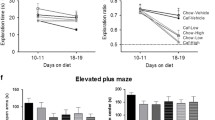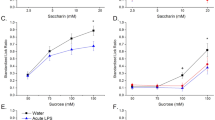Abstract
Pathogenic and protective roles have been attributed to gut commensal microbiota (GCM) in gastrointestinal inflammatory and functional disorders. We have shown that the adaptation to a new environment implies specific changes in the composition of GCM. Here we assessed if environment-related adaptive changes of GCM modulate the expression of colonic Toll-like receptors (TLRs) and sensory-related systems in rats. Adult male SD rats were maintained under different environmental conditions: barrier-breed-and-maintained, barrier-breed adapted to conventional conditions or conventional-breed-and-maintained. Fluorescent in situ hybridization and real-time quantitative PCR (qPCR) were used to characterize luminal ceco-colonic microbiota. Colonic expression of TLR2, TLR4, TLR5, and TLR7, cannabinoid receptors (CB1/CB2), μ-opioid receptor (MOR), transient receptor potential vanilloid (TRPV1, TRPV3, and TRPV4), protease-activated receptor 2 (PAR-2), and calcitonin gene-related peptide were quantified by RT-qPCR. CB1, CB2 and MOR expression, was evaluated also by immunohistochemistry. In rats, housing-related environmental conditions induce specific changes of GCM, without impact on the expression of TLR-dependent bacterial recognition systems. Expression of sensory-related markers (MOR, TRPV3, PAR-2, and CB2) decreased with the adaptation to a conventional environment, correlating with changes in Bacteroides spp., Lactobacillus spp., and Bifidobacterium spp. counts. This suggests an interaction between GCM and visceral sensory mechanisms, which might be part of the mechanisms underlying the beneficial effects of some bacterial groups on functional and inflammatory gastrointestinal disorders.






Similar content being viewed by others
References
Aguilera M, Vergara P, Martinez V (2013) Stress and antibiotics alter luminal and wall-adhered microbiota and enhance the local expression of visceral sensory-related systems in mice. Neurogastroenterology & Motility, in press. doi:10.1111/nmo.12154
Amaral FA, Sachs D, Costa VV, Fagundes CT, Cisalpino D, Cunha TM, Ferreira SH, Cunha FQ, Silva TA, Nicoli JR, Vieira LQ, Souza DG, Teixeira MM (2008) Commensal microbiota is fundamental for the development of inflammatory pain. Proc Natl Acad Sci U S A 105:2193–2197
Blackshaw LA, Brierley SM, Hughes PA (2010) TRP channels: new targets for visceral pain. Gut 59:126–135
Brusberg M, Arvidsson S, Kang D, Larsson H, Lindstrom E, Martinez V (2009) CB1 receptors mediate the analgesic effects of cannabinoids on colorectal distension-induced visceral pain in rodents. J Neurosci 29:1554–1564
Bueno L (2008) Protease activated receptor 2: a new target for IBS treatment. Eur Rev Med Pharmacol Sci 12(Suppl 1):95–102
Camp JG, Kanther M, Semova I, Rawls JF (2009) Patterns and scales in gastrointestinal microbial ecology. Gastroenterology 136:1989–2002
Campbell JH, Foster CM, Vishnivetskaya T, Campbell AG, Yang ZK, Wymore A, Palumbo AV, Chesler EJ, Podar M (2012) Host genetic and environmental effects on mouse intestinal microbiota. ISME J 6:2033–2044
Cario E (2008) Therapeutic impact of toll-like receptors on inflammatory bowel diseases: a multiple-edged sword. Inflamm Bowel Dis 14:411–421
Carvalho FA, Aitken JD, Vijay-Kumar M, Gewirtz AT (2012) Toll-like receptor-gut microbiota interactions: perturb at your own risk! Annu Rev Physiol 74:177–198
Collins SM, Bercik P (2009) The relationship between intestinal microbiota and the central nervous system in normal gastrointestinal function and disease. Gastroenterology 136:2003–2014
Coutts AA, Irving AJ, Mackie K, Pertwee RG, Anavi-Goffer S (2002) Localisation of cannabinoid CB(1) receptor immunoreactivity in the guinea pig and rat myenteric plexus. J Comp Neurol 448:410–422
Davis MP (2012) Drug management of visceral pain: concepts from basic research. Pain Res Treat 2012:265605
Dinoto A, Suksomcheep A, Ishizuka S, Kimura H, Hanada S, Kamagata Y, Asano K, Tomita F, Yokota A (2006) Modulation of rat cecal microbiota by administration of raffinose and encapsulated Bifidobacterium breve. Appl Environ Microbiol 72:784–792
Diop L, Guillou S, Durand H (2008) Probiotic food supplement reduces stress-induced gastrointestinal symptoms in volunteers: a double-blind, placebo-controlled, randomized trial. Nutr Res 28:1–5
Eutamene H, Lamine F, Chabo C, Theodorou V, Rochat F, Bergonzelli GE, Corthesy-Theulaz I, Fioramonti J, Bueno L (2007) Synergy between Lactobacillus paracasei and its bacterial products to counteract stress-induced gut permeability and sensitivity increase in rats. J Nutr 137:1901–1907
Fan YJ, Chen SJ, Yu YC, Si JM, Liu B (2006) A probiotic treatment containing Lactobacillus, Bifidobacterium and Enterococcus improves IBS symptoms in an open label trial. J Zhejiang Univ Sci B 7:987–991
Haarman M, Knol J (2006) Quantitative real-time PCR analysis of fecal Lactobacillus species in infants receiving a prebiotic infant formula. Appl Environ Microbiol 72:2359–2365
Harmsen HJ, Raangs GC, He T, Degener JE, Welling GW (2002) Extensive set of 16S rRNA-based probes for detection of bacteria in human feces. Appl Environ Microbiol 68:2982–2990
Holzer P (2009) Opioid receptors in the gastrointestinal tract. Regul Pept 155:11–17
Honda K, Takeda K (2009) Regulatory mechanisms of immune responses to intestinal bacteria. Mucosal Immunol 2:187–196
Izzo AA, Sharkey KA (2010) Cannabinoids and the gut: new developments and emerging concepts. Pharmacol Ther 126:21–38
Kajander K, Hatakka K, Poussa T, Farkkila M, Korpela R (2005) A probiotic mixture alleviates symptoms in irritable bowel syndrome patients: a controlled 6-month intervention. Aliment Pharmacol Ther 22:387–394
Kelly D, Mulder IE (2012) Microbiome and immunological interactions. Nutr Rev 70(Suppl 1):S18–S30
Livak KJ, Schmittgen TD (2001) Analysis of relative gene expression data using real-time quantitative PCR and the 2(−Delta Delta C(T)) method. Methods 25:402–408
Looijer-van Langen MA, Dieleman LA (2009) Prebiotics in chronic intestinal inflammation. Inflamm Bowel Dis 15:454–462
Ma BW, Bokulich NA, Castillo PA, Kananurak A, Underwood MA, Mills DA, Bevins CL (2012) Routine habitat change: a source of unrecognized transient alteration of intestinal microbiota in laboratory mice. PLoS One 7:e47416
Marques R, Boneca IG (2011) Expression and functional importance of innate immune receptors by intestinal epithelial cells. Cell Mol Life Sci 68:3661–3673
Rakoff-Nahoum S, Paglino J, Eslami-Varzaneh F, Edberg S, Medzhitov R (2004) Recognition of commensal microflora by toll-like receptors is required for intestinal homeostasis. Cell 118:229–241
Rousseaux C, Thuru X, Gelot A, Barnich N, Neut C, Dubuquoy L, Dubuquoy C, Merour E, Geboes K, Chamaillard M, Ouwehand A, Leyer G, Carcano D, Colombel JF, Ardid D, Desreumaux P (2007) Lactobacillus acidophilus modulates intestinal pain and induces opioid and cannabinoid receptors. Nat Med 13:35–37
Selinummi J, Seppala J, Yli-Harja O, Puhakka JA (2005) Software for quantification of labeled bacteria from digital microscope images by automated image analysis. Biotechniques 39:859–863
Teran-Ventura E, Roca M, Martin MT, Abarca ML, Martinez V, Vergara P (2010) Characterization of housing-related spontaneous variations of gut microbiota and expression of toll-like receptors 2 and 4 in rats. Microb Ecol 60:691–702
Veerappan GR, Betteridge J, Young PE (2012) Probiotics for the treatment of inflammatory bowel disease. Curr Gastroenterol Rep 14:324–333
Verdu EF, Bercik P, Verma-Gandhu M, Huang XX, Blennerhassett P, Jackson W, Mao Y, Wang L, Rochat F, Collins SM (2006) Specific probiotic therapy attenuates antibiotic induced visceral hypersensitivity in mice. Gut 55:182–190
Verdu EF, Collins SM (2005) Irritable bowel syndrome and probiotics: from rationale to clinical use. Curr Opin Gastroenterol 21:697–701
Whelan K (2011) Probiotics and prebiotics in the management of irritable bowel syndrome: a review of recent clinical trials and systematic reviews. Curr Opin Clin Nutr Metab Care 14:581–587
Wildt S, Munck LK, Vinter-Jensen L, Hanse BF, Nordgaard-Lassen I, Christensen S, Avnstroem S, Rasmussen SN, Rumessen JJ (2006) Probiotic treatment of collagenous colitis: a randomized, double-blind, placebo-controlled trial with Lactobacillus acidophilus and Bifidobacterium animalis subsp. lactis. Inflamm Bowel Dis 12:395–401
Williams EA, Stimpson J, Wang D, Plummer S, Garaiova I, Barker ME, Corfe BM (2009) Clinical trial: a multistrain probiotic preparation significantly reduces symptoms of irritable bowel syndrome in a double-blind placebo-controlled study. Aliment Pharmacol Ther 29:97–103
Wright KL, Duncan M, Sharkey KA (2008) Cannabinoid CB2 receptors in the gastrointestinal tract: a regulatory system in states of inflammation. Br J Pharmacol 153:263–270
Xavier RJ, Podolsky DK (2007) Unravelling the pathogenesis of inflammatory bowel disease. Nature 448:427–434
Zwielehner J, Lassl C, Hippe B, Pointner A, Switzeny OJ, Remely M, Kitzweger E, Ruckser R, Haslberger AG (2011) Changes in human fecal microbiota due to chemotherapy analyzed by TaqMan-PCR, 454 sequencing and PCR-DGGE fingerprinting. PLoS One 6:e28654
Acknowledgments
We thank Emma Martínez and Antonio Acosta for their technical support in different stages of the study. This work was supported by grants BFU2009-08229 from the Spanish Ministerio de Ciencia e Innovación and 2009SGR-708 from the Generalitat de Catalunya. M. Aguilera received personal support from the FPI program (BES-2010-037699—Spanish Ministerio de Ciencia e Innovación).
Author information
Authors and Affiliations
Corresponding author
Rights and permissions
About this article
Cite this article
Aguilera, M., Vergara, P. & Martínez, V. Environment-Related Adaptive Changes of Gut Commensal Microbiota Do not Alter Colonic Toll-Like Receptors but Modulate the Local Expression of Sensory-Related Systems in Rats. Microb Ecol 66, 232–243 (2013). https://doi.org/10.1007/s00248-013-0241-0
Received:
Accepted:
Published:
Issue Date:
DOI: https://doi.org/10.1007/s00248-013-0241-0




